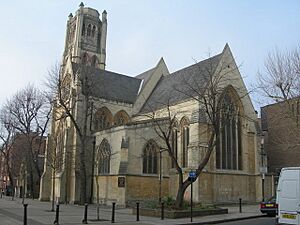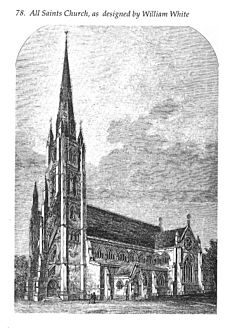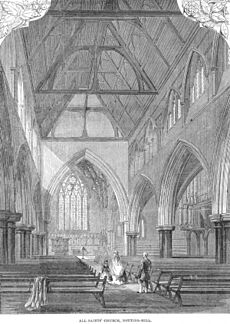All Saints Notting Hill facts for kids
Quick facts for kids All Saints Notting Hill |
|
|---|---|
 |
|
| Location | Talbot Road, Notting Hill |
| Country | United Kingdom |
| Denomination | Church of England |
| Churchmanship | Anglo-Catholic |
| Website | All Saints Notting Hill |
| History | |
| Founder(s) | Samuel Walker |
| Dedication | All Saints |
| Architecture | |
| Heritage designation | Grade II* |
| Designated | 29 July 1949 |
| Architect(s) | William White, with Sir George Gilbert Scott |
| Style | Gothic Revival |
| Years built | 1861 |
| Administration | |
| Deanery | Kensington and Chelsea |
| Archdeaconry | Kensington |
| Episcopal area | Kensington |
| Diocese | London |
| Province | Canterbury |
All Saints Notting Hill is a historic Church of England church located on Talbot Road in Notting Hill, London. It is known for its beautiful Victorian design and colorful decorations.
The church follows the Anglo-Catholic tradition, which means its services have many traditional and ceremonial elements. Its special architecture and history have made it a Grade II* listed building, meaning it is a very important building that must be protected.
Contents
History of the Church
The story of All Saints church begins in 1852. A man named Reverend Dr Samuel Walker, who was also a property developer, wanted to build a grand church for the new neighborhood of Kensington Park.
A Difficult Start
The church was designed by architect William White, with help from the famous Sir George Gilbert Scott. They planned a beautiful building in the Gothic Revival style, which was inspired by medieval cathedrals. An important goal was to have no pew rents, which meant people did not have to pay to sit in certain seats. This made the church open to everyone.
However, Reverend Walker's business plans did not succeed, and he had to sell his land. This left the church only partly built for several years. Because it was an unfinished building site, some people gave it the nickname "All-Sinners-in-the-Mud."
Finally, in 1861, the church was completed under the leadership of Reverend John Light. It cost £25,000, but the tall spire from the original design was never added. The church's tower is 100 feet (about 30 meters) high and is said to look like the famous medieval belfry in Bruges, Belgium.
Surviving World War II
During The Blitz in World War II, All Saints was badly damaged by bombs. The first bombs hit in September 1940, and more attacks followed in 1944. Parts of the church, including two small chapels, were destroyed. After the war, the church was carefully repaired, and the restoration was finished in 1951.
A Place for Music
In the 1960s, the church hall became a popular venue for music. On October 14, 1966, the famous rock band Pink Floyd played one of their first shows there. These events were early versions of what would become the world-famous Notting Hill Carnival. Three years later, another band, Hawkwind, also performed at the hall.
Church Leaders
From 1931 to 1961, the vicar was Father John Twisaday. He was known for his friendly personality and for establishing the high church style of worship that All Saints is known for today. The current vicar is Reverend Charles Card-Reynolds, who started in 2025.
Art and Decoration
Inside the church, you can see beautiful paintings in the chancel (the area around the altar). These artworks were created by the artist Henry Holiday. The colorful and detailed style of the church's interior is a key feature of its Gothic Revival design.
Famous Church Members
One of the most notable people from All Saints' past was Walter Passmore. He was a singer and actor famous for his funny roles in Gilbert and Sullivan operas. Before he became a star, he was a choirboy at All Saints church.
The Church Organs
Music has always been important at All Saints, and it has had several impressive organs over the years.
- The First Organ (1862): The church's first organ was built by the company Gray & Davison. It was shown at the Great London Exhibition of 1862 before being installed in the church.
- The Second Organ (1902): A new, larger organ with three keyboards was built by Norman and Beard.
- The Current Organ (1952): After the old organ was damaged in the war, it was rebuilt by Percy Daniel & Co. The pipes were cleverly placed inside the church tower, with the sound flowing out into the main church area.



